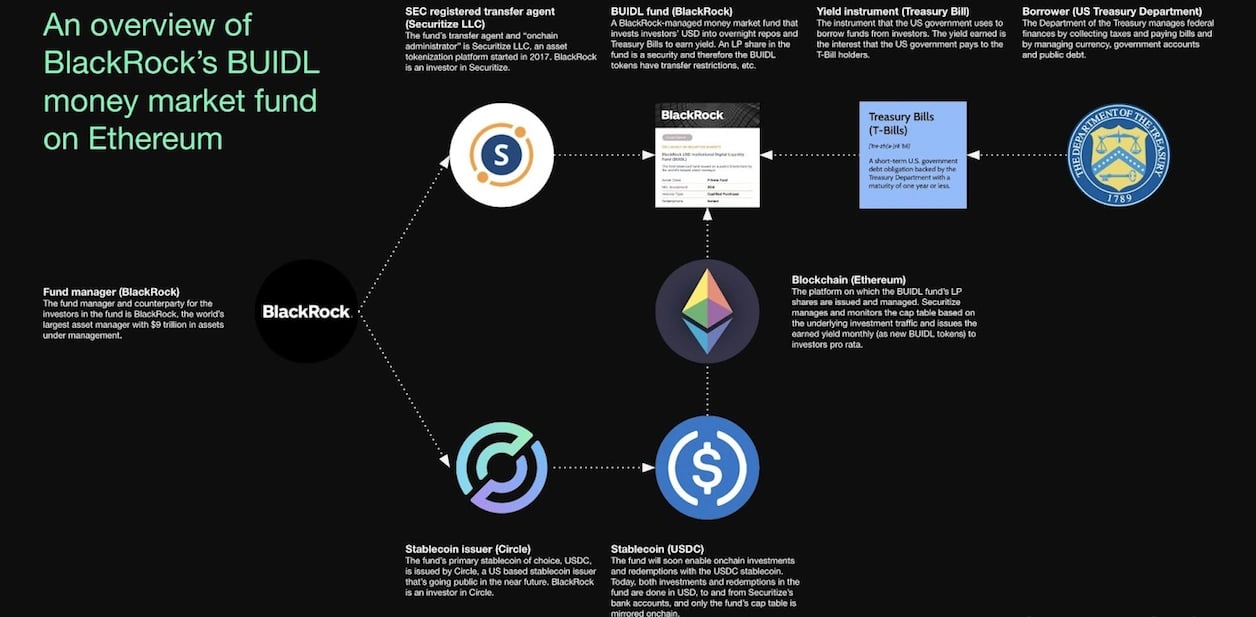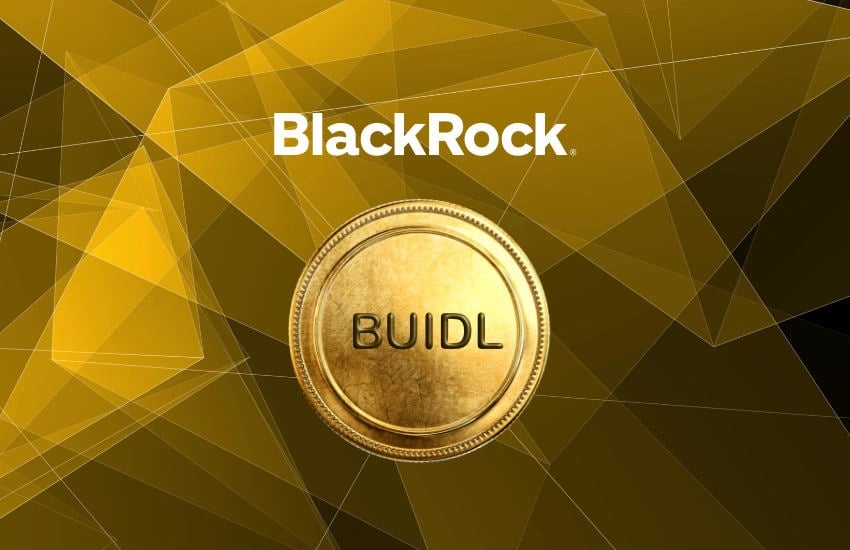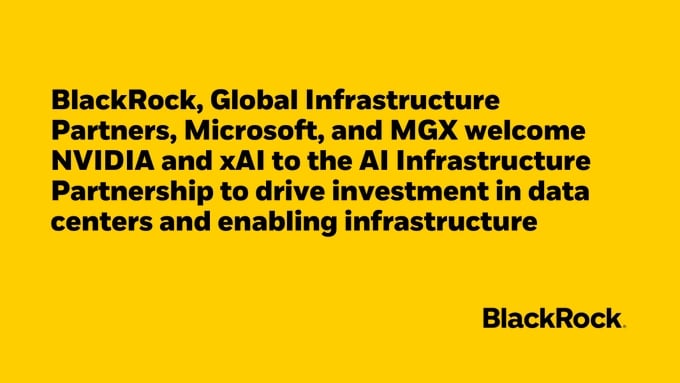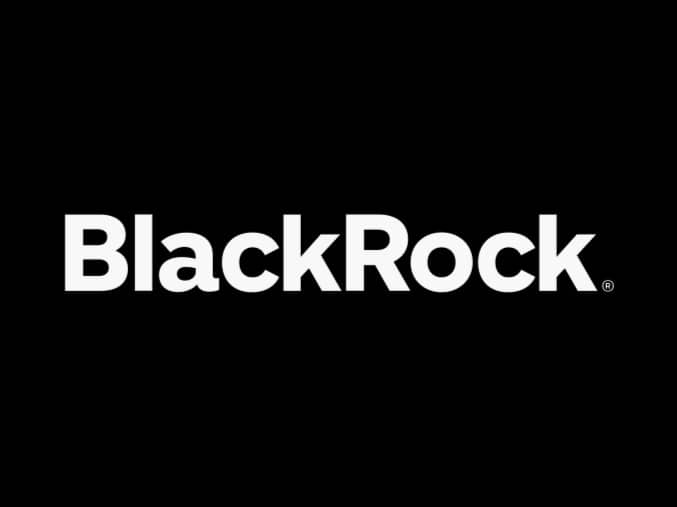订阅 wiki
Share wiki
Bookmark
BlackRock USD Institutional Digital Liquidity Fund (BUIDL)
BlackRock USD Institutional Digital Liquidity Fund (BUIDL)
BlackRock USD Institutional Digital Liquidity Fund (BUIDL) 是由全球最大的资产管理公司贝莱德 (BlackRock) 推出的代币化货币市场基金,旨在为机构投资者提供访问数字资产的途径,同时保持传统货币市场投资的安全性和流动性。 [1]
概述
BlackRock USD Institutional Digital Liquidity Fund (BUIDL) 代表了贝莱德通过将区块链技术与传统货币市场基金相结合,战略性地扩展到 加密货币 领域。BUIDL 最初在 以太坊 上推出,现在跨越七个 区块链 运行,包括 Solana,允许投资者利用区块链的账本和支付功能。这一举措符合金融领域将金融资产从传统格式过渡到基于区块链的系统的更广泛的代币化趋势。BUIDL 构建于区块链技术之上,与传统金融工具相比,可实现更快的结算时间、更高的透明度和更高的运营效率。 [2]
作为货币市场基金,BUIDL 主要投资于短期、高质量的债务证券,包括美国国债、商业票据和其他现金等价物。该基金旨在保持稳定的净资产价值 (NAV),同时为机构投资者提供有竞争力的收益率。BUIDL 已集成到更广泛的 真实世界资产 (RWA) 代币化领域,并且对贝莱德基金日益增长的兴趣表明机构对代币化 RWA 的需求不断增长,这得益于监管清晰度的提高,正如欧洲 RWA 平台 Brickken 的联合创始人兼首席执行官 Edwin Mata 所指出的那样。 [1] [3] [8]

主要特点
BUIDL 提供了几个独特的特点,使其与传统货币市场基金和其他数字资产区分开来:
- 代币化:该基金的份额以数字代币的形式在区块链上表示,从而实现可编程功能并与数字资产生态系统集成。
- 机构关注:与许多数字资产不同,BUIDL 专为机构投资者设计,具有适当的合规性、安全性和报告功能。
- 监管合规:该基金在现有货币市场基金监管框架内运作,同时利用 区块链 技术。
- 稳定性:作为货币市场基金,BUIDL 旨在保持稳定的价值,使其比许多 加密货币 的波动性更小。
- 流动性管理:该基金提供机构级流动性管理,并具有 区块链 技术的效率优势。
- 生态系统集成:BUIDL 可以与各种区块链协议和 去中心化金融 (DeFi) 应用程序集成。
技术基础设施
BUIDL 的技术基础将传统金融基础设施与 区块链 技术相结合:
- 区块链平台:虽然关于底层 区块链 的具体细节有限,但该基金可能利用企业级区块链解决方案,该解决方案优先考虑安全性、可扩展性和监管合规性。
- 智能合约:该基金可能采用 智能合约 来自动化基金管理的各个方面,包括发行、赎回和股息分配。
- 托管解决方案:贝莱德已实施机构级数字资产托管解决方案,以保护该基金的代币化资产。
- 集成能力:该技术堆栈包括与传统银行系统的集成能力,从而可以在传统金融轨道和基于 区块链 的系统之间实现无缝移动。
- 合规机制:该基础设施包含自动化合规机制,以确保遵守 KYC/AML 要求和其他监管义务。
投资策略
BUIDL 的投资策略遵循传统的货币市场基金原则,同时利用 区块链 技术的优势:
- 资产配置:该基金主要投资于短期、高质量的债务工具,包括美国国债、政府机构债务、存款凭证、商业票据和其他货币市场工具。
- 风险管理:BUIDL 采用货币市场基金典型的保守风险管理实践,侧重于资本保全和流动性。
- 收益生成:该基金旨在提供与传统货币市场基金相比具有竞争力的收益率,这可能会因通过 区块链 技术获得的运营效率而提高。
- 流动性管理:投资策略优先考虑保持足够的流动性以满足赎回请求,同时优化回报。
代币经济学

BlackRock 代币 (BUIDL)
该基金可在多个 区块链 上使用,包括 以太坊、Polygon、Avalanche、Optimism、Arbitrum、Aptos 和 Solana。 [4] [5]
代币效用
- 资产支持代币:BUIDL 代币代表底层货币市场基金中的份额,每个代币都由该基金的短期债务证券投资组合支持。
- 价值稳定性:与许多 加密货币 不同,BUIDL 旨在保持稳定的价值,类似于传统货币市场基金。
- 供应动态:代币供应量根据投资者的流入和流出基金而扩大和收缩,而不是遵循预定的发行时间表。
- 收益分配:底层资产产生的回报可能会根据其所有权比例分配给代币持有者。
- 赎回机制:代币持有者可以将其代币兑换为基金资产的底层价值,从而在代币价格和基金净资产价值之间建立直接关联。
合作伙伴关系
AI 基础设施合作伙伴关系 (AIP)
BUIDL 已与 Global Infrastructure Partners (GIP)、Microsoft、MGX、NVIDIA、xAI、GE Vernova 和 NextEra Energy 建立了战略合作伙伴关系,作为 AI 基础设施合作伙伴关系 (AIP) 的一部分。此次合作侧重于投资于支持 AI 的数据中心和能源基础设施,以满足不断增长的计算资源需求。
NVIDIA 和 xAI 在 AI 加速和数据中心基础设施方面贡献了技术专业知识,而 GE Vernova 和 NextEra Energy 则致力于能源解决方案以支持 AI 增长。该合作伙伴关系旨在通过利用私人和机构投资者的资本来调动高达 1000 亿美元的投资。
BUIDL 参与 AIP 符合开发开放式 AI 生态系统的努力,确保美国、经合组织国家和主要合作伙伴地区的可扩展性和广泛的行业参与。 [6] [7]

Ondo Finance & BUIDL
Ondo Finance 已与贝莱德的 BUIDL 合作,以增强 区块链 生态系统内的流动性。此次合作旨在增加投资者的参与度,并利用区块链技术来改进资产管理和 清算。Ondo Finance 是 BUIDL 项目的重要合作伙伴,计划通过将 BUIDL 与其 OUSG 产品集成,使其储备多元化到五个新的区块链中,该产品支持去中心化国库持有。此举旨在增强区块链网络中的流动性,为 Ondo 的投资者营造更高效的交易环境。 [9]
与 Frax Finance 集成
2025 年初,Frax Finance 推出了一种新的 稳定币,frxUSD,其结构由贝莱德 USD Institutional Digital Liquidity Fund (BUIDL) 中持有的代币化资产支持。frxUSD 的发行标志着一个用例,其中链上稳定价值由受监管机构管理的传统资产基金中的份额抵押。
frxUSD 的发行和代币化通过 Securitize 进行,Securitize 既是代币化平台又是转账代理。每个 frxUSD 代币对应于 BUIDL 基金中的等值份额。底层基金资产包括短期美国国债工具、现金和回购协议,其结构旨在提供资本保全和每日流动性。
支持 稳定币 的份额保存在隔离的 钱包 中,链上可见性支持对储备金的独立验证。此模型使用可公开访问的交易数据来确认抵押品持有量,从而用基于 区块链 的可审计性取代链下证明。
根据公开披露,frxUSD 在一个将受监管证券纳入基于 区块链 的基础设施的框架内运作。该结构符合 Frax 部署由 真实世界资产 支持的稳定币,同时与 去中心化金融 (DeFi) 协议集成的目标。
BUIDL 在此安排中的作用代表了使用传统金融工具的代币化表示作为 稳定币 设计中的抵押品。frxUSD 机制定位于将基金代币化应用于 区块链 原生资产的更广泛趋势中,从而在金融系统之间提供新的互操作性形式。 [10] [11] [12] [13] [14] [15]
发现错误了吗?
